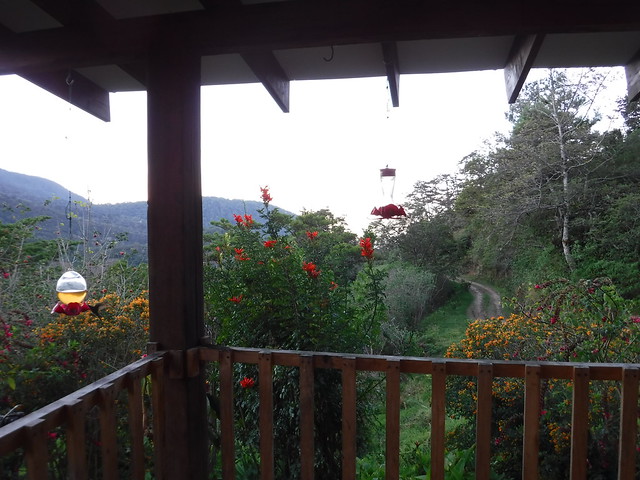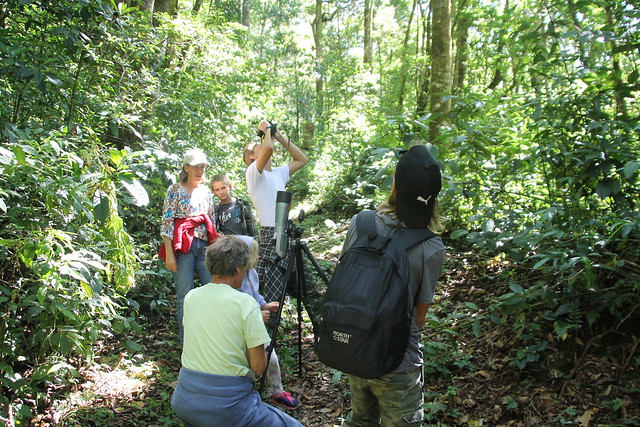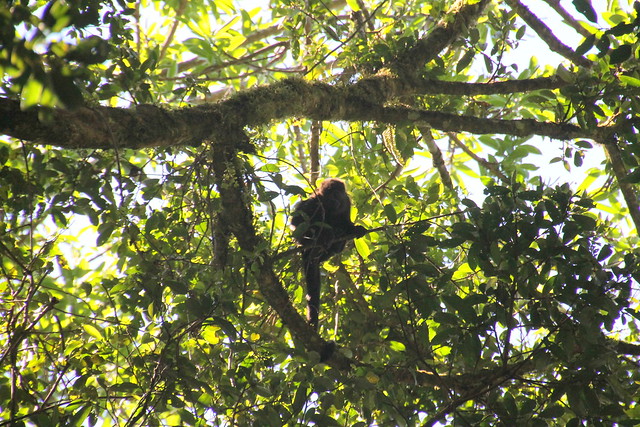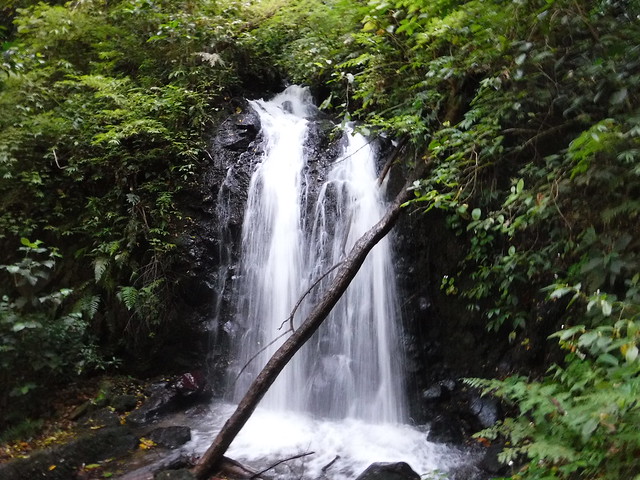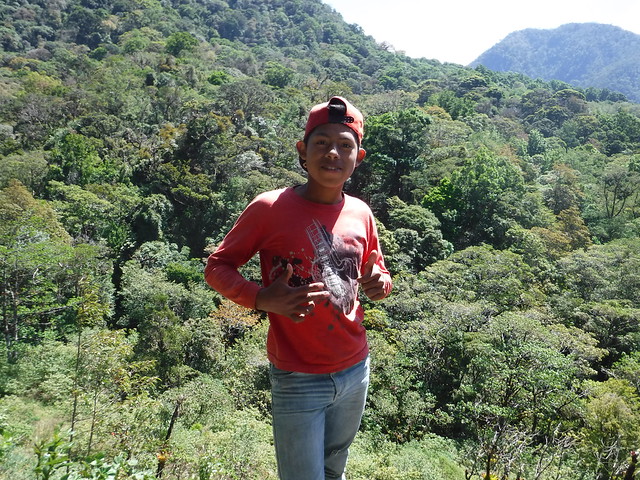We have spent several weeks in Bocas del Toro, Panama, and have decided that we like the place. However, Bocas Town seems a little small, and we were wanting a taste of the rest of the country. Chiefly, the mountains. Spurred on, no doubt, by the stunning success of the Cartagena Vacation, Mom, through a mixture of Spanglish phone calls, strategically-invited dinner guests, and magical powers, secured three days in a mountain eco-lodge, and three more days in the town of Boquete, at the house of a new friend of ours. She also managed to arrange transportation for seven people plus luggage all the way there and back.
The first few days of our trip would be spent at the cabaña at Mount Totumas. We would be living in a large cabin, hike all day on the trails, and enjoy cooler weather in the cloud forest biome. The second half of the week would be spent in a large apartment in Boquete, a nice little town with restaurants and hostels and tour companies offering everything from ziplining to hot springs to views of the Atlantic and Pacific from the top of 11,000-foot Volcan Barú.
The trip sounded pretty good, but the transportation did not. First, we had to take a water taxi to Bocas Town at 9:30 A.M., wait for half an hour, and then take another boat to the mainland. After another half-hour wait, we would have a four-hour bus ride to Boquete, on the other side of the isthmus of Panama. At 3:30 P.M., two drivers would meet us in a pick-up truck and taxi for the two-hour drive to Volcan, a small town up in the mountains, where we could buy a few groceries. At the turn-off to Mount Totumas, the taxi would turn back, and three of us would pile into the back of the 4×4 pickup truck, along with all our luggage, for the bumpy, hour-long ride to the cabaña, arriving just before dark.
Amazingly, it all went off without a hitch. The view from the road was quite extraordinary. We drove through the mountains, with a steep wooded slope on one side of the road, and the whole countryside spread out like a blanket on the other. Squinting in the right direction, I could almost make out the pale line of the Pacific Ocean. As the sky darkened, we arrived at the cabaña, rapidly unpacked our things, and headed to the Lodge for dinner.
The Bellbird Lodge is cozy, wooden, and warm. Sitting on one of the comfy sofas, I half-expected to see snow falling in the darkness outside the window. Sadly, there is no snow in the cloud forest. Dinner was excellent, cooked by Jeff’s wife, Alma, daughter, Karin, and helper, Hilda. Afterward, we walked back to the cabin along the dark track, pointing out lightning bugs, and admiring the stars. With practically no light pollution, night among the mountains is akin to being out at sea.
Back at the cabin, we explored our new digs. The cabin was made of wood, had two floors, a full kitchen, two bathrooms, and slept seven easily. And it had a bath tub! I haven’t seen a bath tub in forever! Tired after sitting in a car all day doing nothing, we all chose our beds, and went to sleep. We spent three days in the cabaña, hiking the trails, hanging out at the lodge, and enjoying the change of climate, not to mention scenery. We ate mainly at home, Mom cooking with the groceries from Volcan. We also spent a fair amount of time watching the hummingbirds.
There were two hummingbird feeders out on the porch, and they received constant business. Seventeen species of hummingbird have been seen at Mount Totumas, but we only observed about a dozen. There were hummingbirds of all colors and sizes, from the large Violet Sabrewing, to the green and yellow White-Throated Mountain Gem, not much larger than a bumblebee. During our stay, Sarah had to refill the hummingbird feeders twice. The activity was especially intense around the feeders at the back of the hostel. If you took all the feeders down, and held one up in your hand, the hummingbirds would buzz right up, and start chugging down sugar water right next to your face.
On the first day, Jeff took us on an introductory hike, on a trail called ‘Big Tree Loop.’ There certainly were some very big trees. The cabaña lies in a rare ‘cloud forest’ biome. This is a high-altitude, old-growth, tropical forest. It is very biodiverse, containing many different types of trees and plants within a small area. As we walked on the dirt trail among the trees, Jeff told us about some of the wildlife that lived in and around the property. These included pumas, ocelots, tapirs, and hundreds of species of birds. However, during our walk, we saw not a single animal on the ground. As in most tropical forests, the action is primarily in the canopy above. One of the most notable examples is the monkey.
Mount Totumas is home to three types of monkey: capuchin, spider, and howler. Halfway through the hike, we spotted a small community of howler monkeys. Jeff saw one first, then Aaron, then the rest of us: a little howler monkey-head poking out from behind a branch fifty feet up in the trees. Jeff set up a small telescope that he brought along a for spotting birds, and trained it on the monkey. After looking at the ugly little primate for a few minutes, we discovered that it was not alone. Altogether, there were about a dozen monkeys sitting in that one tree, just off the path. While we were watching them, we were careful to keep our distance. These monkeys had a reputation for urinating and defecating on trespassers to their territory.
The others seemed to be content to ogle the monkeys from a safe distance, but I soon became bored. I walked off the path a short way, to the base of a big, tall tree. Hanging next to the trunk, from a hefty branch up above, was a vine. And boy, what a vine! It was as thick as my wrist, and had another one just as thick spiraling around it. After testing to see if it was secure, I wasted no time in climbing up. The first branch of the tree was about fifty feet in the air. By the time I got up there, my arms were quite fatigued, so I scrambled into a sitting position on the branch, and looked around. The monkeys were only a few trees away, and from that distance I could smell them a little too clearly. Meanwhile, back on the ground, Jeff started making deep barking sounds, attempting to provoke the alpha male. Just exactly why he was doing this, I don’t know, but in any case, it worked. The monkeys went completely bananas, whooping and hollering, and zeroing in on my tree. Confronted with the prospect of getting pasted with primate poo, I wisely decided that discretion was the better part of valor, and beat a hasty retreat down the vine.
Aside from the monkeys, the rest of the hike was pretty uneventful. We saw tall trees, flowers, fungi, and a slime mold. The lack of wildlife sightings might possibly have been due to the rambunctious nature of the children on the hike. The afternoon was a little more interesting. Jeff took us down to the hydro-plant that supplies power to the entire facility. The water is piped from a nearby stream. Where the pipe meets the generator, it narrows, forcing a pressurized jet of water into the turbine. The turbine turns the generator to make 7500 watts of electricity, and the water flows back into the stream. The system provides more than enough clean, reliable energy to meet the demand of the lodge, hostel, and cabaña. We also saw the greenhouse, where most of the vegetables served at the lodge are grown. As people who generally prefer to be self-sufficient, we were very impressed with the self-reliance off Jeff’s little operation.
The next day, we got up early. This was made possible by an excited five-year-old stomping around creaky wooden flooring. After breakfast, Aaron and I packed a backpack with water and a map of the trails, and went out hiking. It was rather cold in the morning, but we hoped to see a little more action in the forest than the day before. We had studied the map before went out, and decided to do the one marked “Cascadas” first. The trail descended into the valley below the lodge. There was less wind down there, and we soon took off our unnecessary windbreakers. The canopy above was denser, casting the trail in green shadow. Water dripped from every leaf, and the dirt underfoot was damp. Unfamiliar and exotic bird calls filled the crisp air, and in the distance, we could hear the deep barking grunt of the howler monkeys. We passed two tall waterfalls, columns of white foam that gurgled, frothed, and went bubbling and swirling out beneath the trees, deeper into the valley.
We had just passed the second waterfall, when somebody caught up with us on the trail. He was a local boy, dressed in faded blue jeans and a red shirt. In broken English, he introduced himself as David. He was 14, and his family lived on the property. We introduced ourselves, and told him where we were going. He seemed content to hike along with us. His English was about as good as our Spanish, so we could generally understand each other. We didn’t talk much, just sort of walked together. Occasionally, one of us would ask what a word was in Spanish, or he would ask about an English word. David obviously knew a lot about the local flora and fauna, but was only able to communicate a little. He was astonished that we lived on a boat, and were home-schooled.
After about 30 minutes, we reached a fork in the trail. We still had several hours to kill, so instead of going back to the cabin, the three of us went on the other trail. In this manner, we went on to hike segments of every single trail on the property. We slowly moved out of the valleys, and up into the hills and meadows above the lodge. On the top of one of the hills was a large rock that jutted out over the valley. A sign nearby labeled it as ‘”The Thinking Rock.” It was not hard to see why. At about noon, we descended to the lodge and bid David farewell. We never got the chance to see him again, but I wish we had; in that friendship, at least, language wasn’t really a barrier.
The next day was our last at Mount Totumas. We packed up our various belongings, then it was off to the Bellbird Lodge for a breakfast of eggs and toast. We decided to do some last-minute hiking before the truck came to fetch us as noon. By popular demand, we settled on “Roble,” a relatively short trail that Aaron, David and I had hiked the day before. Part of the reason for choosing this trail was its proximity to “The Thinking Rock,” with which the others had become inordinately obsessed. The hike was just as beautiful as before. Due to the increased wind, we did not see any birds, and due to the chattering of small children, we did not see any beasts. After about thirty minutes of toil, we reached the object of out labors: “The Thinking Rock.” We all sat down on it, while Dad tried (and largely failed) to set up the camera for a time-delayed shot. After messing around on the rock for fifteen minutes, we continued down the trail. The one interesting thing that we saw on the way back was the intake for the hydro generator.
The truck arrived right on time, and we all piled our junk in the bed, then Aaron, Sam, and I piled ourselves in. The ride out of the property was just as bouncy as the ride in (what did I expect?). Halfway down the road, we made a minor detour to see “Los Pozos,” the hot springs. It was a small orange pool of water, about a meter across. The only thing remarkable about it was that it was boiling. Hey, after hiking eight hours to see the boiling lake in Dominica, this little saucepan just wasn’t that impressive. Ironically, it was two feet from an icy cold stream. Mom put her finger into the pool, just to see if it was really boiling (smart woman). Apparently it was, or close to it, because the finger was retracted mighty fast.
We lingered about five minutes, then we were on our bumpy way. We were met at the end of gravel road by the same rattletrap taxi which had carried us before. With all the seats in the truck taken, Aaron, Dad, and I got in to the taxi. We settled in for the two-hour ride, with Mount Totumas behind, and Boquete ahead. Our time on the mountain was a high point, in more ways than one, but there was still more to come…



